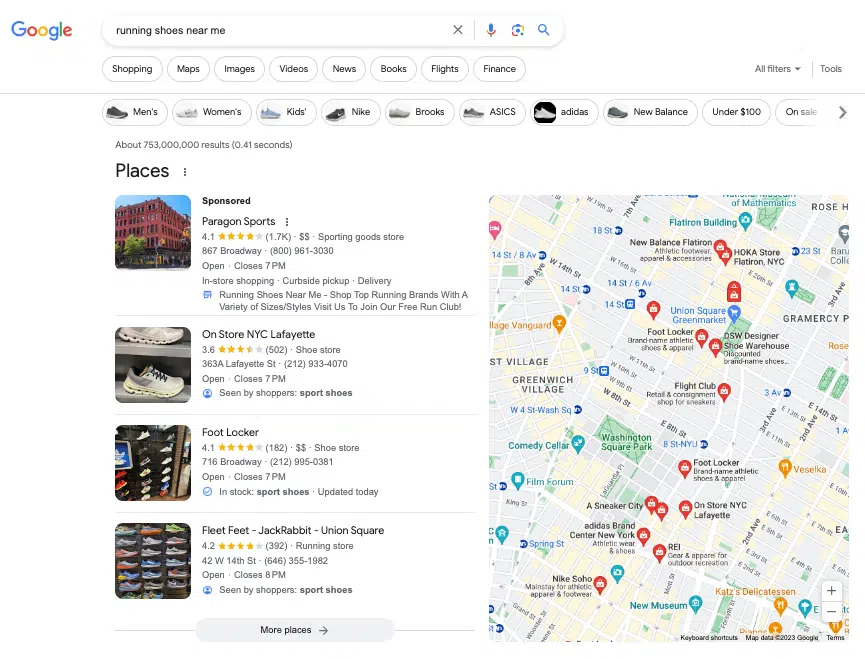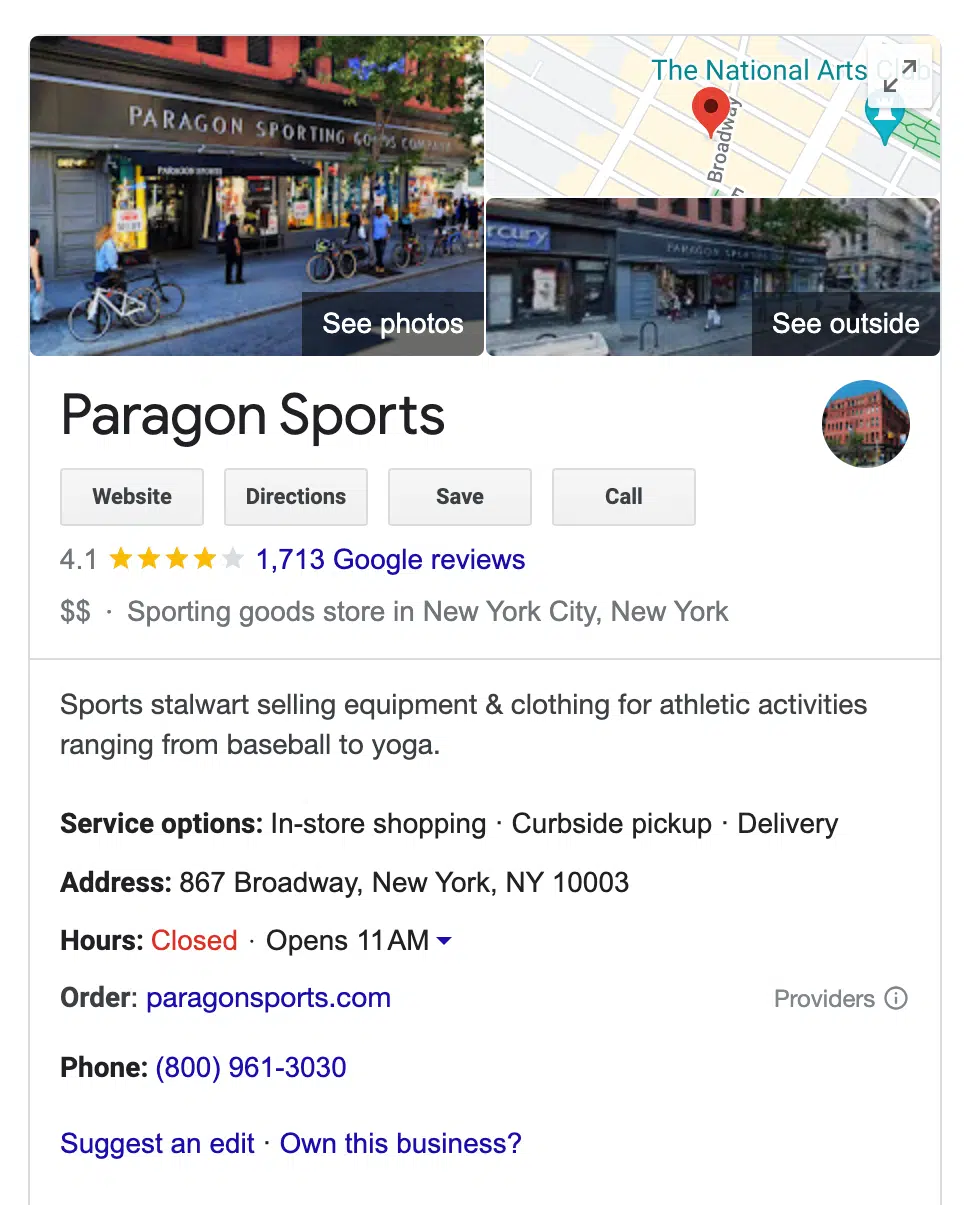Optimizing local listings for SEO is essential for businesses looking to convert online interest into real-world visits and sales.
In 2022, up to 87% of consumers relied on Google to evaluate local businesses. Ignoring your company's local online presence can give your competitors an advantage and lead to missed sales opportunities.
Here's an overview of SEO best practices for managing and optimizing your local listings for SEO.
Local Listings: What are local listings and why are they important?
Local listings are the core of your business's local SEO strategy.
A local listing is an online profile that provides important business details such as name, address, phone number, and business hours, and typically appears on directory websites and search engine results.
These listings are extremely important for businesses aiming to capture local searches, ensuring that potential customers find accurate and consistent information, and search engines such as Google search for accurate business information. Helps you add relevant data to your results.
The Google Business Profile (GBP) is almost always the most important local listing for any business, given its site visibility and integration with Alphabet's overall products, including Search and Maps. Creating a customized GBP is free and relatively easy.
A verified Google Business Profile helps ensure your business appears in Google Map Pack or Google Local Pack search results.
As in the example below, [running shoes near me]map packs consist of top-ranked local listings of users' search locations, displayed prominently above the first traditional organic search results.


These first results have significantly higher organic click-through rates, so it's important to optimize your business profile to meet the needs of search engines.
It's important to note that Google isn't the only location-based listing platform you should know about. For restaurants, Yelp provides reviews, ratings, and photos, but the popularity of the platform can greatly influence consumer decisions.
Similar to GBP, Bing Places is another platform where businesses can list their details, ensuring visibility among Microsoft Bing users.
Depending on your investment level, a third-party local listing tool like Yext can help your business integrate across hundreds of directories and automatically sync important information like business hours and special events as they evolve. Masu.
Get the daily newsletter search that marketers rely on.
Manage and optimize your local listings
You can think of local listings as the web's digital storefront.
For businesses looking for optimal online visibility and local market reach, setting up a Google Business Profile with basic information just scratches the surface.
This ongoing process includes:
- Ensure accuracy of listings.
- Update information
- Relationship with reviews.
Let's take a closer look at Paragon Sports' business profile, one of our findings. [running shoes near me] Example above:


The Paragon Sports listing spans more than half of the entire first page of results and contains a lot of useful information for local searchers.
- Service options.
- business hours.
- telephone number.
- special event.
- In stock in store.


As users continue scrolling, they can access reviews, learn more about your business, and access your external social profiles.
The information displayed here is a combination of company-provided content, user-generated content, and content provided by Google.
Let's take a closer look at the basic elements of the first part of that equation.
NAP: Basic Components of Powerful Local Listings
NAP (Business nCandy, beaddress, and pHon No.) Consistency between listings is a fundamental requirement for local SEO.
Inconsistent NAP information across different platforms can confuse search engines and ultimately affect rankings.
More importantly, potential customers may lose trust if they encounter different details on the web. For local SEO success:
- Make sure your website's NAP matches the NAP of all local listings.
- Audit your list regularly and fix any discrepancies.
- Use the exact same format everywhere, down to the smallest details such as “St.” vs. “street”.
Update the list regularly
Outdated information can lead to missed opportunities and customer dissatisfaction.
Imagine a searcher trying to visit your store or calling an out-of-service phone number based on outdated address information.
It's important to update your list whenever key business information changes.
When determining how a company appears in search results, Google's local algorithm uses a combination of factors that are primarily biased toward:
- Relevance.
- distance.
- prominence.
Incomplete or inaccurate data will ultimately cause you to lose support within your local pack.
Constantly audit updates for accuracy and consistency across all platforms.
Google allows users to suggest changes to profile categories such as availability, business hours, and business details.
Although these may help identify required changes, they may be inaccurate.
Verified owners of Google Business Profiles can approve, decline, or change these updates.
Add photos and in-store products
You need visual content to tell your business story.
Photos give potential customers a glimpse of your products, set expectations, and help them make informed decisions.
Visually appealing and relevant images significantly increase user engagement, making them more likely to interact with your listing and ultimately choose your business over your competitors. .
Be sure to add high-quality visuals to your business profile that meet Google's requirements. Best practices include:
- Showcase both the outside and the inside of your business from different angles.
- Make sure all images are non-pixelated and high resolution.
- We will rotate photos with the latest seasonal information.
Additionally, many local listing platforms, including Google, allow businesses to highlight specific products available in-store.
Be sure to take advantage of the benefits by choosing popular products, products specific to your business, or related products currently on promotion and providing detailed information such as price and description.
Monitor and respond to reviews
When it comes to local listings and Google Business Profiles, customer feedback is just as important as information provided by your business. In the review he has two roles.
- They influence the perception of potential customers.
- They affect search rankings.
While a series of positive reviews can increase a company's credibility, negative reviews can be counterproductive if not handled properly.
Search engines consider businesses with positive reviews to be more valuable to users and often reward them with better local rankings.
Overall, regardless of the feedback, you should always encourage your customers to share their reviews online and respond honestly.
We always appreciate reviewers who take the time to leave comments that address specific concerns and maintain a professional tone.
This fosters customer loyalty and reduces negative third-party consequences for brand queries that are difficult to control.
Google also collects and aggregates reviews from third-party sources such as Facebook, Yelp, and consumer directories, so don't forget to include other relevant platforms as appropriate.
Dig deeper: Unlock the potential of Google Reviews for local SEO
Beyond Local Listings: Additional Local SEO Strategies
Local listings are a vital part of local SEO, but to truly dominate local searches, you need to expand your efforts beyond listings to your entire website and online presence.
Here are some important additional strategies to step up your local SEO game.
Leverage local keywords and content
Implement schemas and structured data
- Use the Local Business Schema on your website to provide location-specific information to search engines.
- Be specific and thorough when implementing your schema.
- Regularly audit your site for additional schema opportunities.
Location pages and on-page optimization
- If your company has multiple locations, create a separate page for each location to increase local search visibility.
- Use a clear URL structure and integrate local keywords into your content and meta tags.
- Embedding Google Maps improves user experience and search engine recognition.
Learn more: How to do competitive analysis for local SEO
Harness the power of local listings
Optimizing local listings for SEO is essential for businesses to increase their online visibility and attract local customers.
Managing your listing effectively increases your chances of appearing prominently in local search results and provides potential customers with accurate, up-to-date information that drives online and in-person traffic.
As the digital marketing landscape continues to evolve, prioritizing local listings and integrating them with your broader SEO strategy will help you stay competitive and capture the attention of increasingly location-conscious consumers. This is the key.
Learn more: 5 tips to boost your local SEO efforts
The opinions expressed in this article are those of the guest author and not necessarily those of Search Engine Land. Staff authors are listed here.


